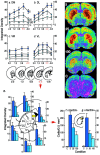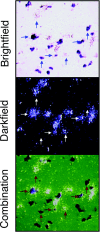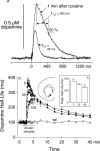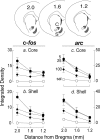The rate of cocaine administration alters gene regulation and behavioral plasticity: implications for addiction
- PMID: 15254092
- PMCID: PMC6729536
- DOI: 10.1523/JNEUROSCI.1205-04.2004
The rate of cocaine administration alters gene regulation and behavioral plasticity: implications for addiction
Abstract
The rapid delivery of drugs of abuse to the brain is thought to promote addiction, but why this occurs is unknown. In the present study, we characterized the influence of rate of intravenous cocaine infusion (5-100 sec) on three effects thought to contribute to its addiction liability: its ability to block dopamine (DA) uptake, to activate immediate early gene expression, and to produce psychomotor sensitization. Rapid infusions potentiated the ability of cocaine to block DA reuptake, to induce c-fos and arc mRNA expression, especially in mesocorticolimbic regions, and to produce psychomotor sensitization. Thus, the rate at which cocaine is delivered influences both its neurobiological impact and its ability to induce a form of drug experience-dependent plasticity implicated in addiction. We propose that rapidly delivered cocaine may be more addictive, in part, because this more readily induces forms of neurobehavioral plasticity that lead to the compulsive pursuit of drugs.
Figures






References
-
- Abreu ME, Bigelow GE, Fleisher L, Walsh SL (2001) Effect of intravenous injection speed on responses to cocaine and hydromorphone in humans. Psychopharmacology (Berl) 154: 76-84. - PubMed
-
- Benoit-Marand M, Jaber M, Gonon F (2000) Release and elimination of dopamine in vivo in mice lacking the dopamine transporter: functional consequences. Eur J Neurosci 12: 2985-2992. - PubMed
-
- Berretta S, Robertson HA, Graybiel AM (1992) Dopamine and glutamate agonists stimulate neuron-specific expression of Fos-like protein in the striatum. J Neurophysiol 68: 767-777. - PubMed
Publication types
MeSH terms
Substances
Grants and funding
LinkOut - more resources
Full Text Sources
Other Literature Sources
Medical
